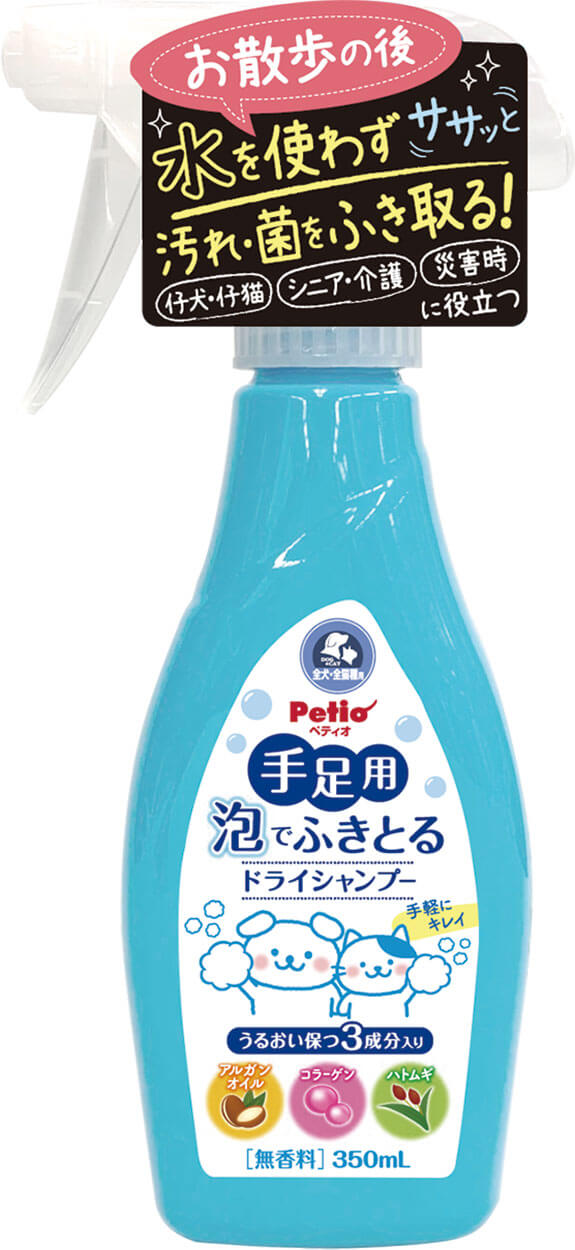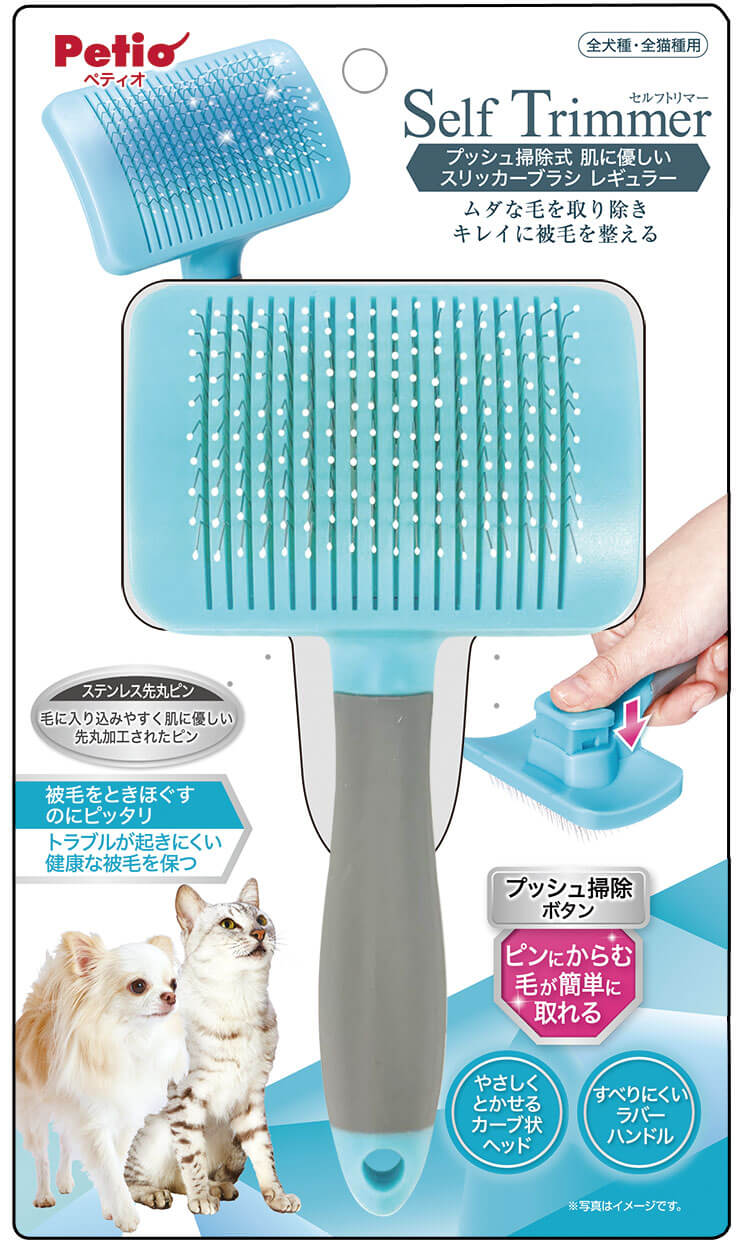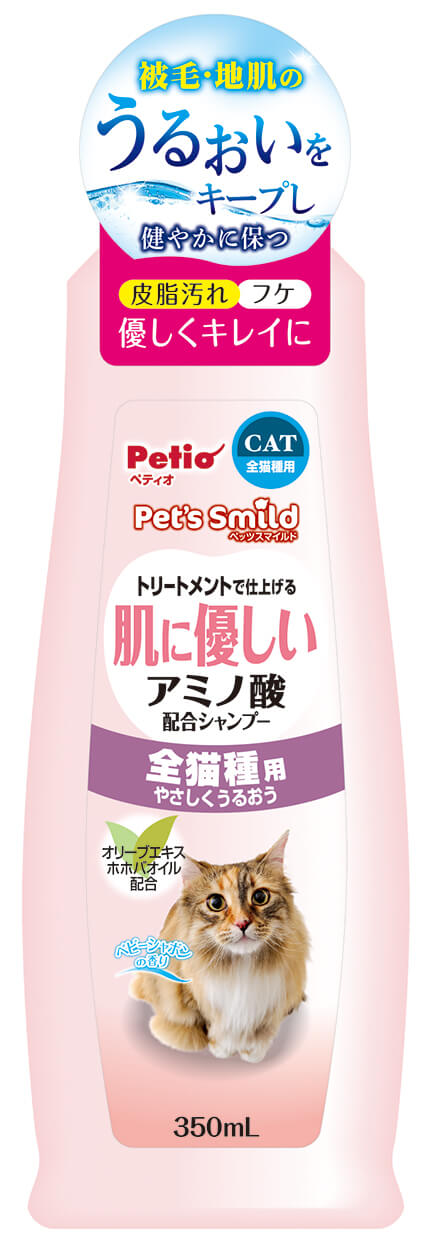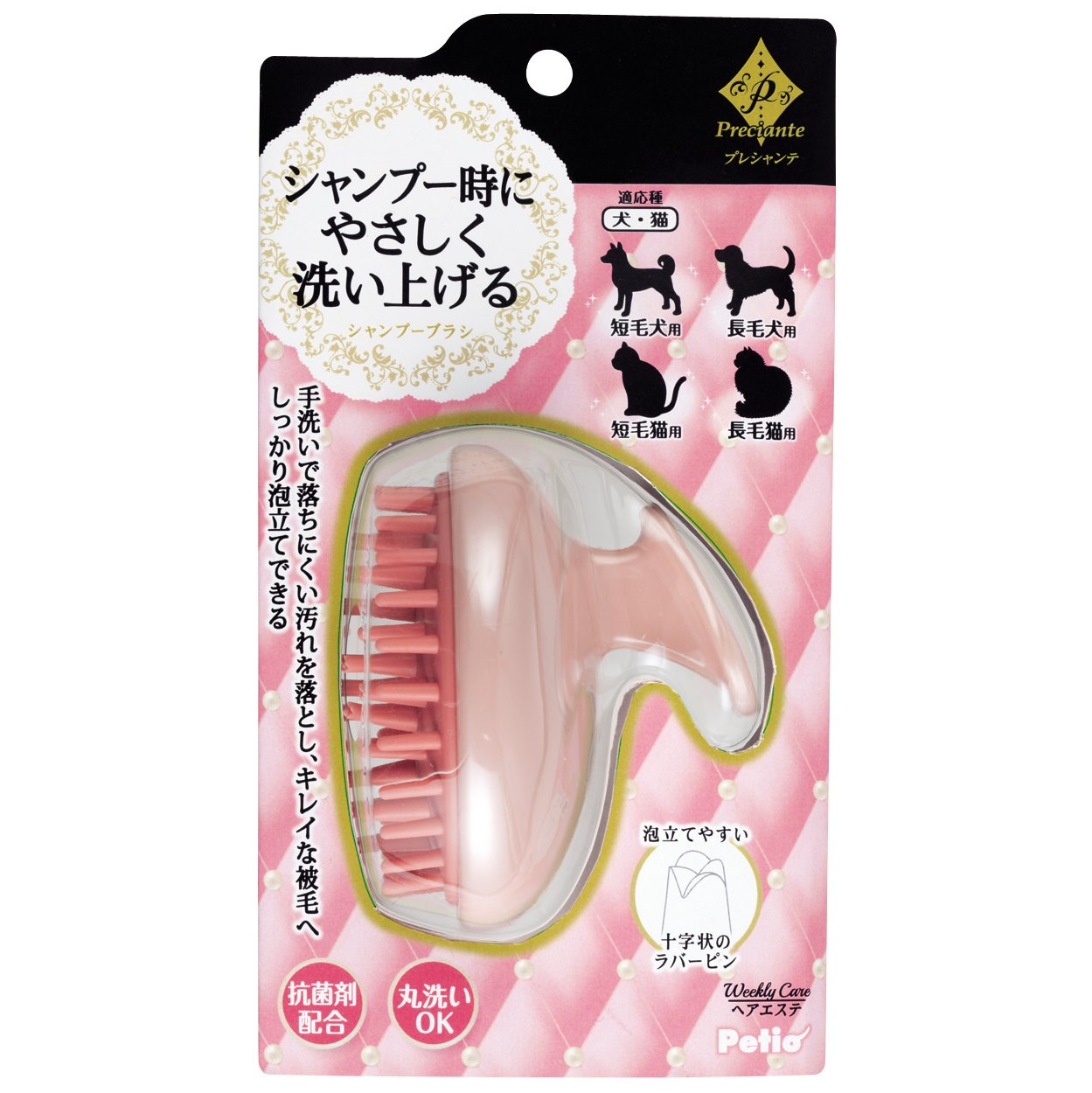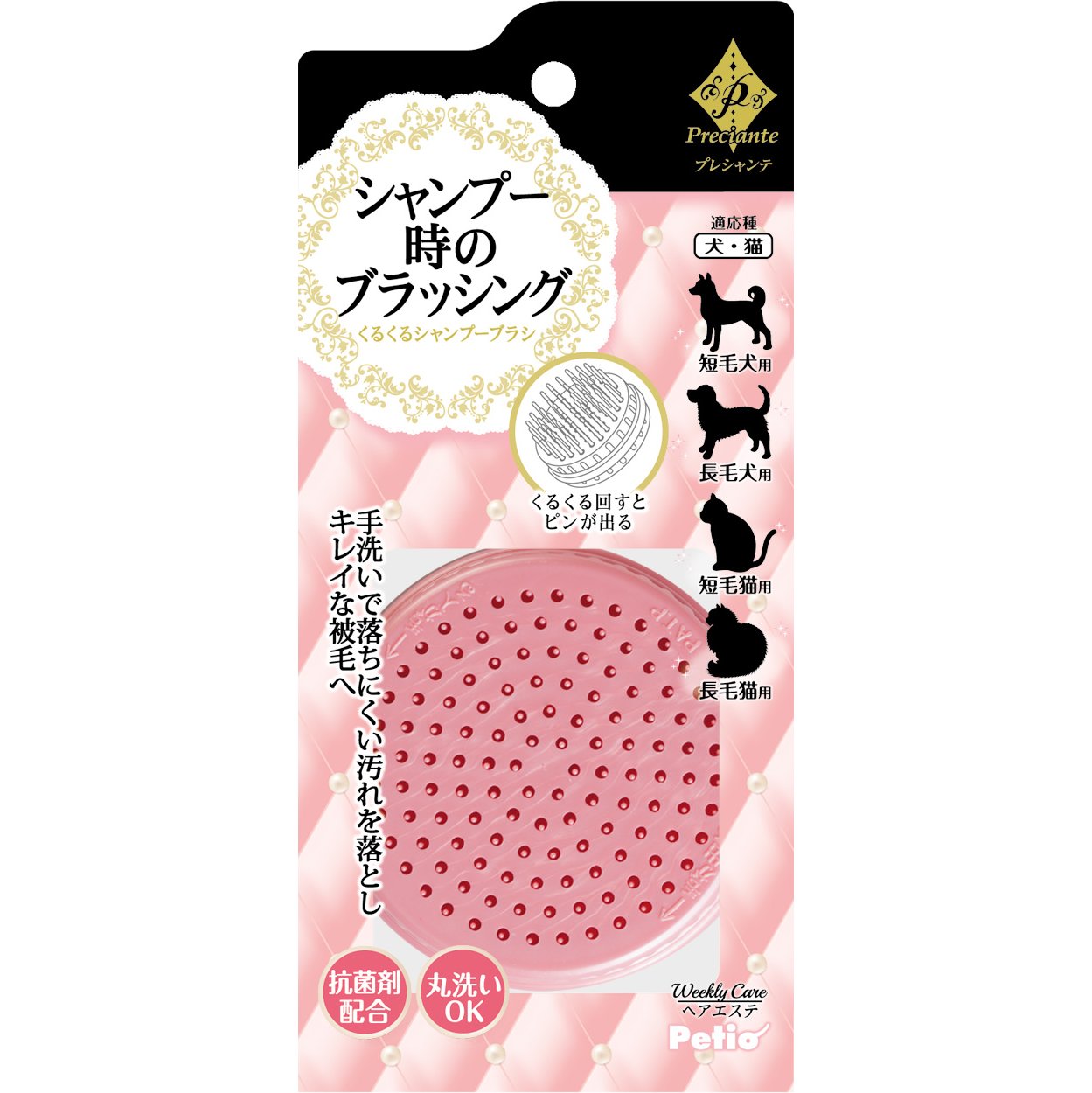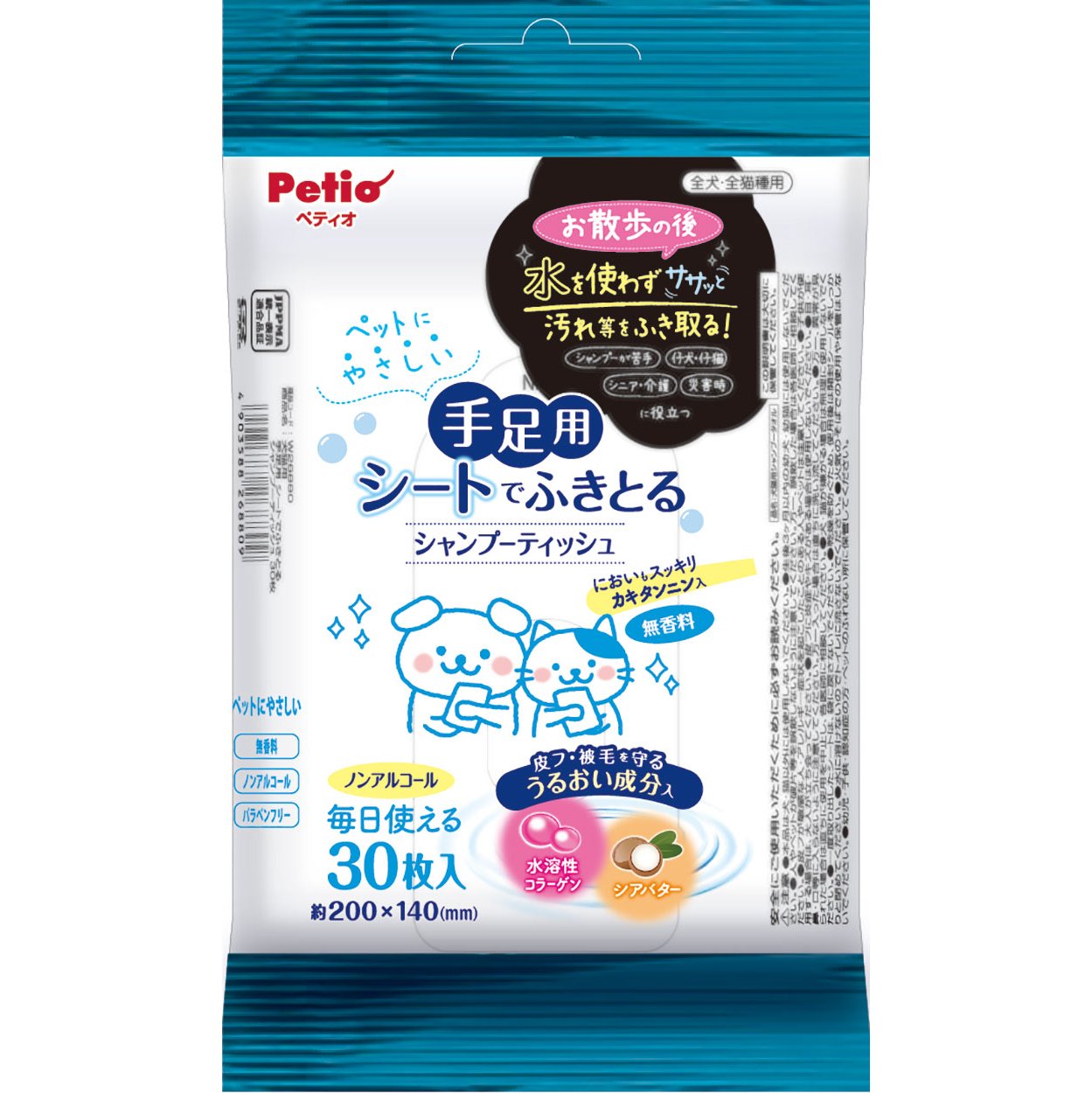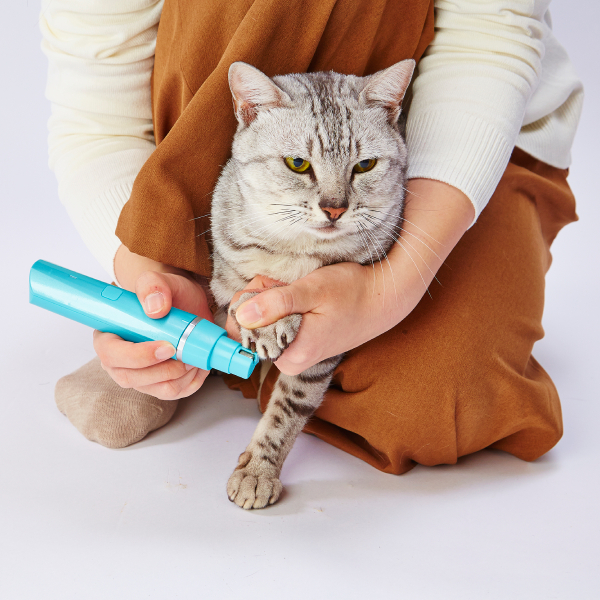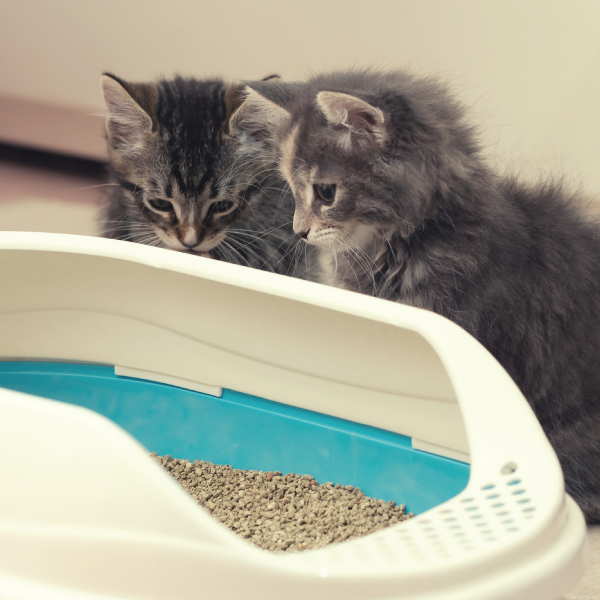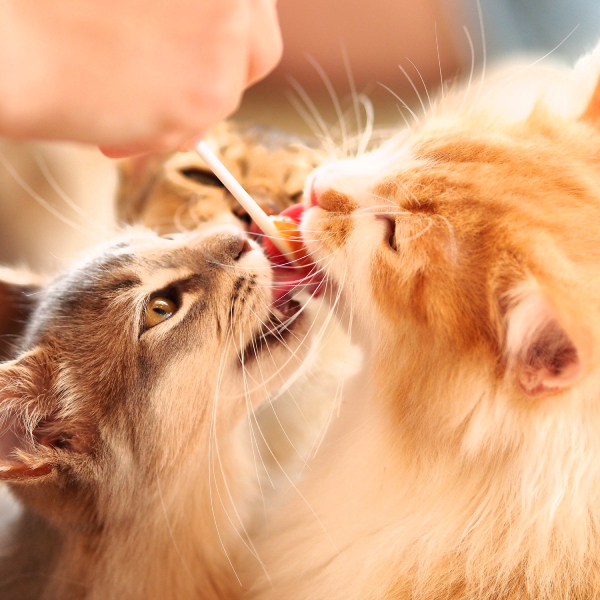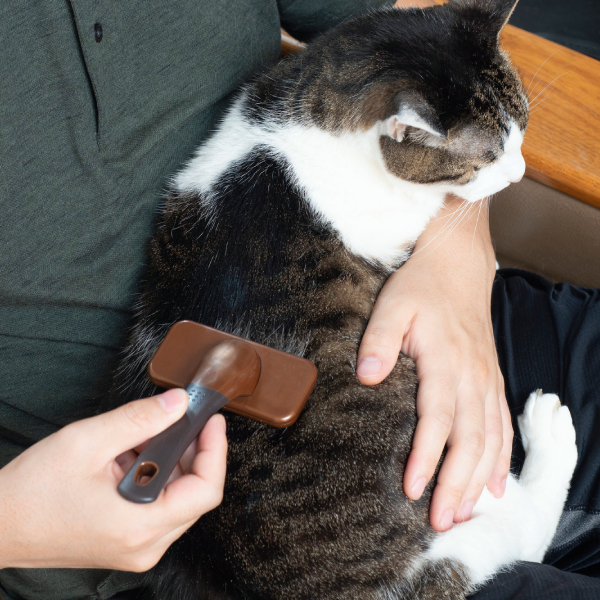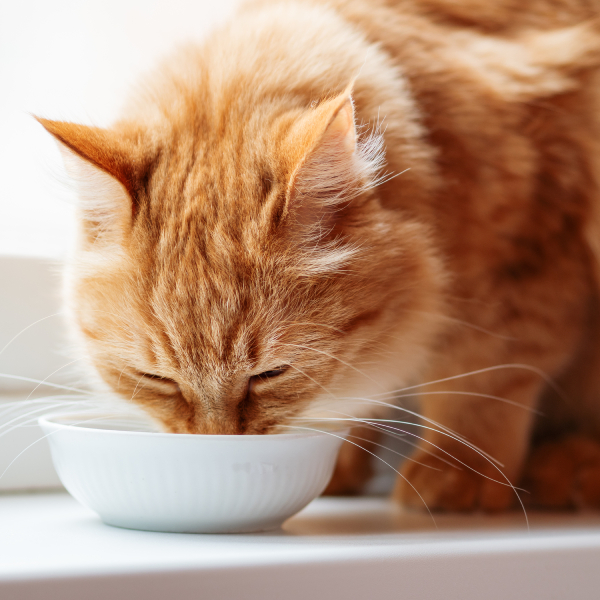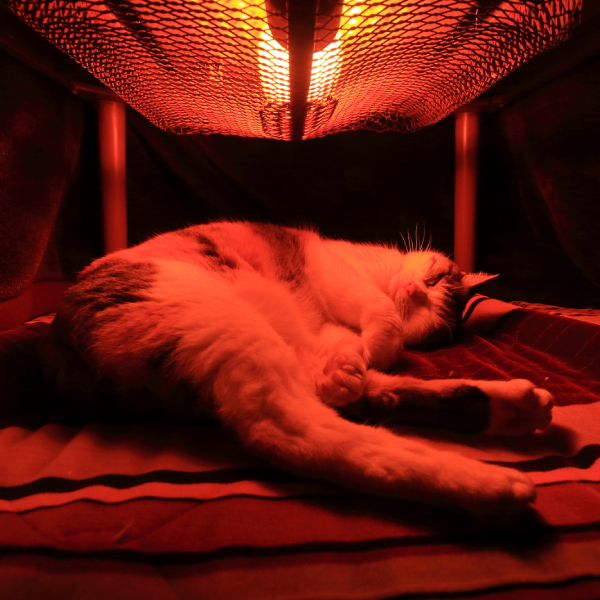特集/Pickup
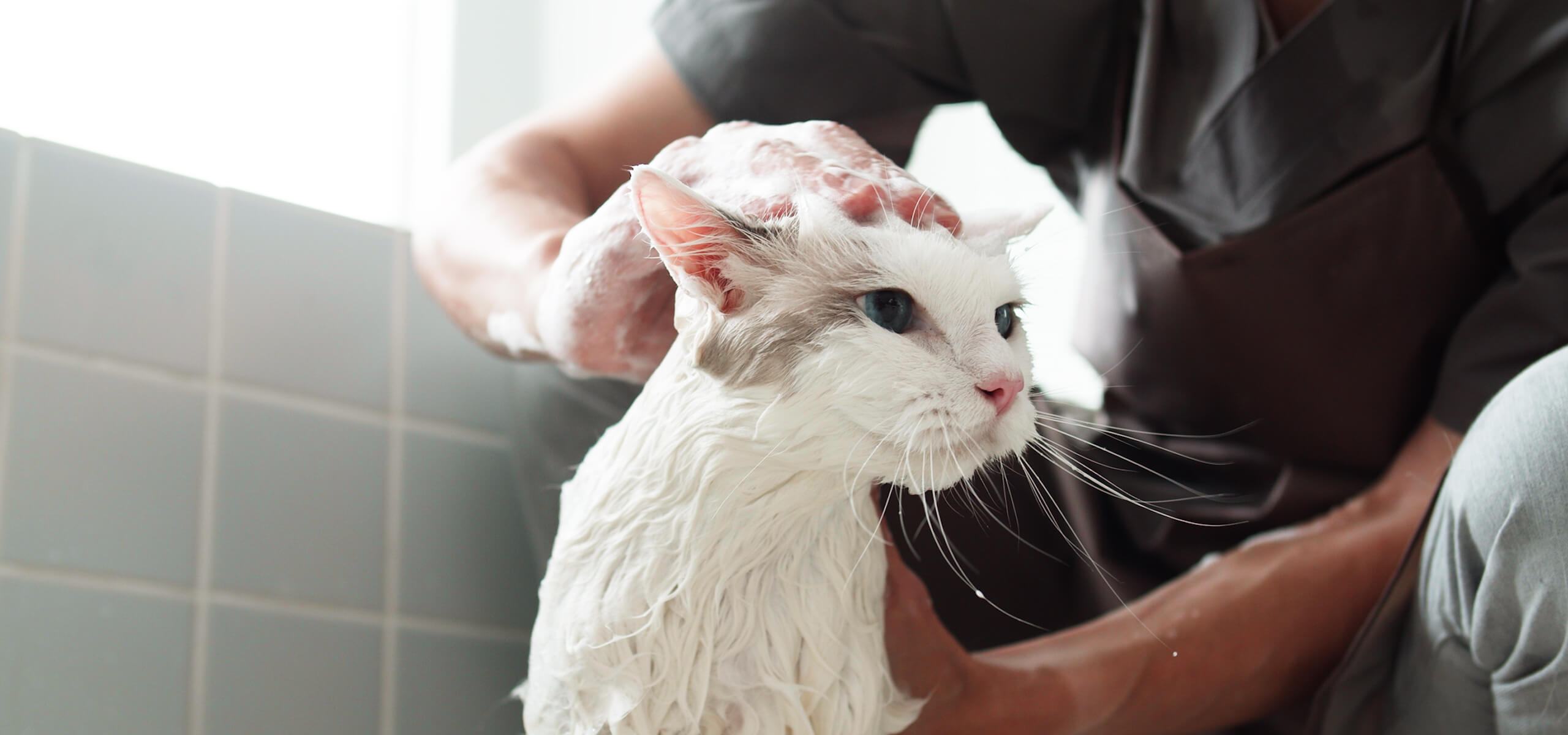
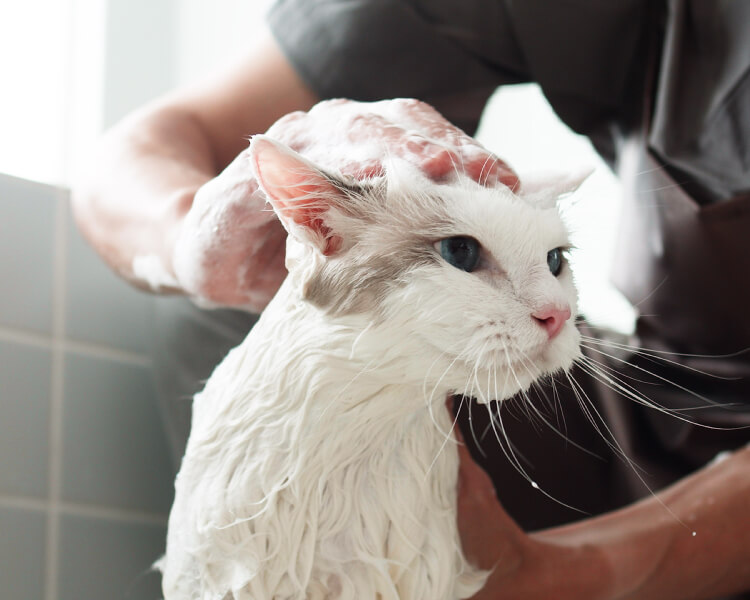
今回はそんな方のために、猫のシャンプーの方法や、猫用のシャンプー選びのポイントなどについて解説します。(最終更新日2023年3月31日)

監修
静岡県島田市向谷3-918-9
TEL 0547-33-6010
北里大学獣医学部獣医学科卒業。専門学校ルネサンス・ペット・アカデミー非常勤講師、日本ペットマッサージ協会とペット薬膳国際協会の講師を務める。東日本大震災における被災動物レスキュー活動などにも参加。一般的な西洋医療のほか、鍼灸治療や漢方、ペットマッサージなどを通して動物の健康に取り組む。
1【まずは動画で解説!】獣医が教える!猫をシャンプーする方法
猫のシャンプーはどのように行うのがよいのでしょうか。
手順や押さえておくべきポイントなどを動画にまとめましたので、まずはこちらをご覧ください。
2そもそも、猫にシャンプーは必要?
猫は水を苦手とする動物です。そもそも、猫にシャンプーが必要なのかどうかについてご説明します。
みずから毛づくろいをする猫は、基本的にシャンプーの必要はない
猫は、元々体臭が少ない動物です。そして、自分で全身をくまなく毛づくろいする「セルフグルーミング」を行い、体を清潔に保とうとする習性を持っています。ですから、基本的には健康な猫にシャンプーは必要ありません。
完全室内飼いの猫で、特に短毛種であれば、こまめにブラッシングをしてあげていれば、お手入れとしては十分といえます。
被毛や皮膚の清潔を保つために、シャンプーが必要な場合も
猫の状態によっては、シャンプーが必要な場合もあります。長毛種であれば、どうしても被毛に汚れがつきやすく、ブラッシングのみで汚れをすべて取り除くのは難しいかもしれません。
皮膚疾患のある猫や、皮膚が脂っぽい、フケが出ている、排泄物で毛が汚れてしまったという場合は、シャンプーをしてさっぱり清潔にさせてあげることが必要です。
また、換毛期などに毛玉の嘔吐が多い猫も、定期的にシャンプーをしてあげることで嘔吐の頻度を下げることができるという効果があります。
さらに、猫にシャンプーを行うことで、人の猫アレルギーをやわらげる効果もあるといわれています。猫のシャンプーにより、猫アレルギーの原因となる成分である、猫の皮膚や唾液腺から分泌されるアレルゲンを一時的に低減させる効果があるという研究結果も出ているのです。
その効果は永続的なものではありませんが、猫アレルギーを持つ方の訪問があるタイミングなどに、あらかじめ猫のシャンプーをしておくと症状を緩和することができるでしょう。
3猫のシャンプーを行う前にしておくべきこと
猫のシャンプーを行う前には、準備すべきことがあります。具体的には、下記の2点について準備しておきましょう。
猫の食欲や排泄物・皮膚の状態をチェック
シャンプーをする前に、猫の状態をしっかり観察することが大切です。食欲や排泄物の状態、皮膚の異常など、少しでも普段と違った様子が見られる場合、シャンプーは先送りにしてください。猫のシャンプーをするのは、健康状態が万全なときだけにしましょう。
ブラッシングをいつも以上にしっかり行う
シャンプーをする前には、ブラッシングをしてほこりを落とし、毛玉や毛のもつれをほぐしておきましょう。このとき、抜け毛もしっかり取り除いておきます。特に、長毛種は被毛が絡まりやすいので、念入りにブラッシングを行ってください。
また、シャンプーの最中には嫌がって暴れることも考えられるため、飼い主がケガをしないよう、爪もあらかじめ切っておくことをおすすめします。
4猫をシャンプーするときの手順とポイント
猫をシャンプーするには、どのような手順で行えば良いのでしょうか。押さえておくべきポイントとともに、順番に説明していきます。

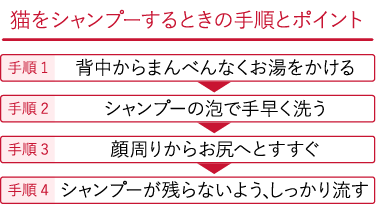
1. 背中からまんべんなくお湯をかける
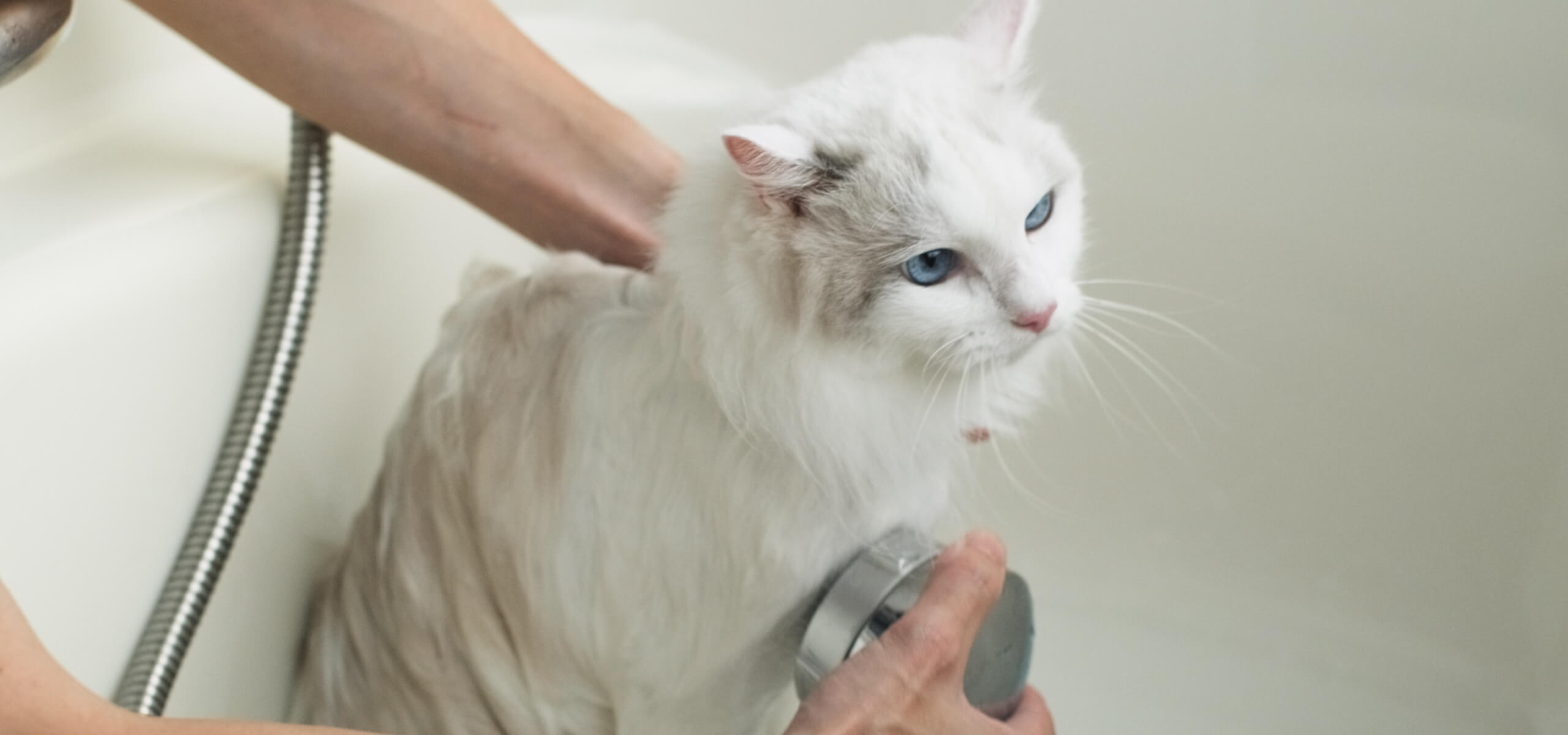
まずは、被毛をしっかり濡らします。濡らすことにより大きな汚れを洗い流し、被毛の根元・皮膚までしっかり湿らせて、シャンプーの泡立ちを良くするためです。お湯をかける際には、まずは背中からお湯をかけ、次にお尻や後ろ足を濡らし、その後におなか、そして最後に顔へと向かうようにしましょう。
お湯の温度は、人肌より少しぬるめの30~35℃くらいにします。人がふれて少し物足りないくらいの温度が猫にとっての適温です。
シャワーをあてる場合はできるだけ水流を弱めに設定し、シャワーヘッドを猫の体になるべく押しあてるようにするか、自分の手のひらでシャワーヘッドをつかみながら、お湯が勢い良く猫の体にあたるのを防ぎます。これは、水のしぶきや音で猫を驚かさないためです。
どうしてもシャワーを嫌がる猫には、洗面器からお湯をゆっくりかけてあげたり、タオルやスポンジを利用して少しずつ濡らしたりするなどの工夫をするのがおすすめです。
2. シャンプーの泡で手早く洗う
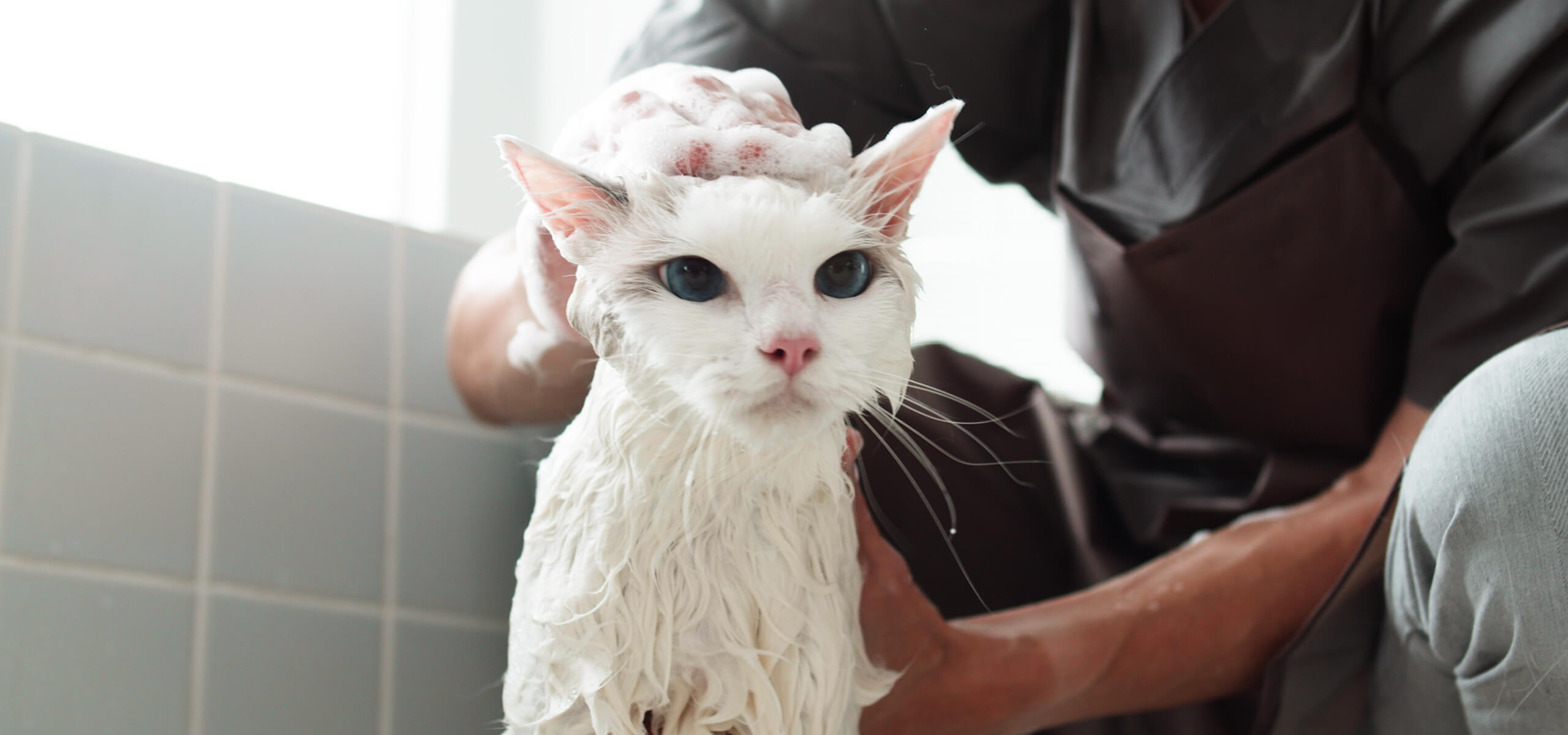
被毛と皮膚が十分に濡れたら、手に取ったシャンプーを泡立てます。このとき、皮膚に到達するよう、たまに毛並みに逆らうようにしながら洗います。長毛種の場合は被毛が絡まってしまう可能性があるため、できるだけ毛の流れに沿って洗いましょう。
ゴシゴシこすらず、手で包み込んでやさしくマッサージするように洗うのがポイントです。特に念入りに洗うべき場所は、汚れの溜まりやすいしっぽや肛門周辺のほか、足先や指のあいだなどです。頭や顔周りは、手で直接洗うのではなく、ガーゼなどを使って洗ってあげるのも良いでしょう。目や口にシャンプーが入ると危険なため、入ってしまわないように十分注意してください。
シャンプーを手に取ってよく泡立てることができない場合は、あらかじめ洗面器などにシャンプーを入れて、そこに勢い良くシャワーでお湯を入れ、泡立てておくのがおすすめ。そうすることにより、猫を待たせることなく手早くシャンプーすることができますので、ぜひ試してみてください。
3. 顔周りからお尻へとすすぐ
しっかり泡をなじませて被毛と皮膚を洗うことができたら、次はシャンプーを流す工程です。
まずは、顔周りからすすいでいきます。被毛を濡らすときと同じ要領で、シャワーヘッドを猫の体に押しあてるようにお湯をかけ、上から下に流すようにシャンプーを落としていきます。このとき、お尻に向かってしっかりすすいでいきましょう。
4. シャンプーが残らないよう、しっかり流す
洗い流しが不十分だと、シャンプーが綺麗に流れず、身体の一部分に残ってしまいます。そうすると後々、皮膚トラブルの原因になりかねません。また、猫が全身をグルーミングするときに、シャンプーを口に入れてしまうこともあるでしょう。そのため、地肌までしっかりシャンプーを洗い流す必要があります。
5猫のシャンプーを行う上での注意点
水が苦手な猫をシャンプーするときには、いくつか注意点があります。まず、そもそもなぜ猫は水が苦手なのでしょうか。それは、野生の頃に半砂漠地帯に住んでいたことから、体が濡れることに慣れておらず、細くてやわらかい被毛は撥水性が弱く、一度濡れるとなかなか乾かないという理由があるのです。
そのため、長時間をかけてシャンプーをしてしまうと、猫は大抵嫌がります。ですから、無理にシャンプーを続けず、全身を洗うのが難しければお尻周りと足先だけをまずは洗ってあげるようにしましょう。
また、猫の表皮の厚みは約0.1mm程度しかなく、人間の赤ちゃんよりも薄いといわれています。シャンプーをするときは、ゴシゴシ強く洗いすぎて皮膚を傷つけてしまわないよう、十分な注意が必要です。
6猫のシャンプー後の乾かし方のコツ
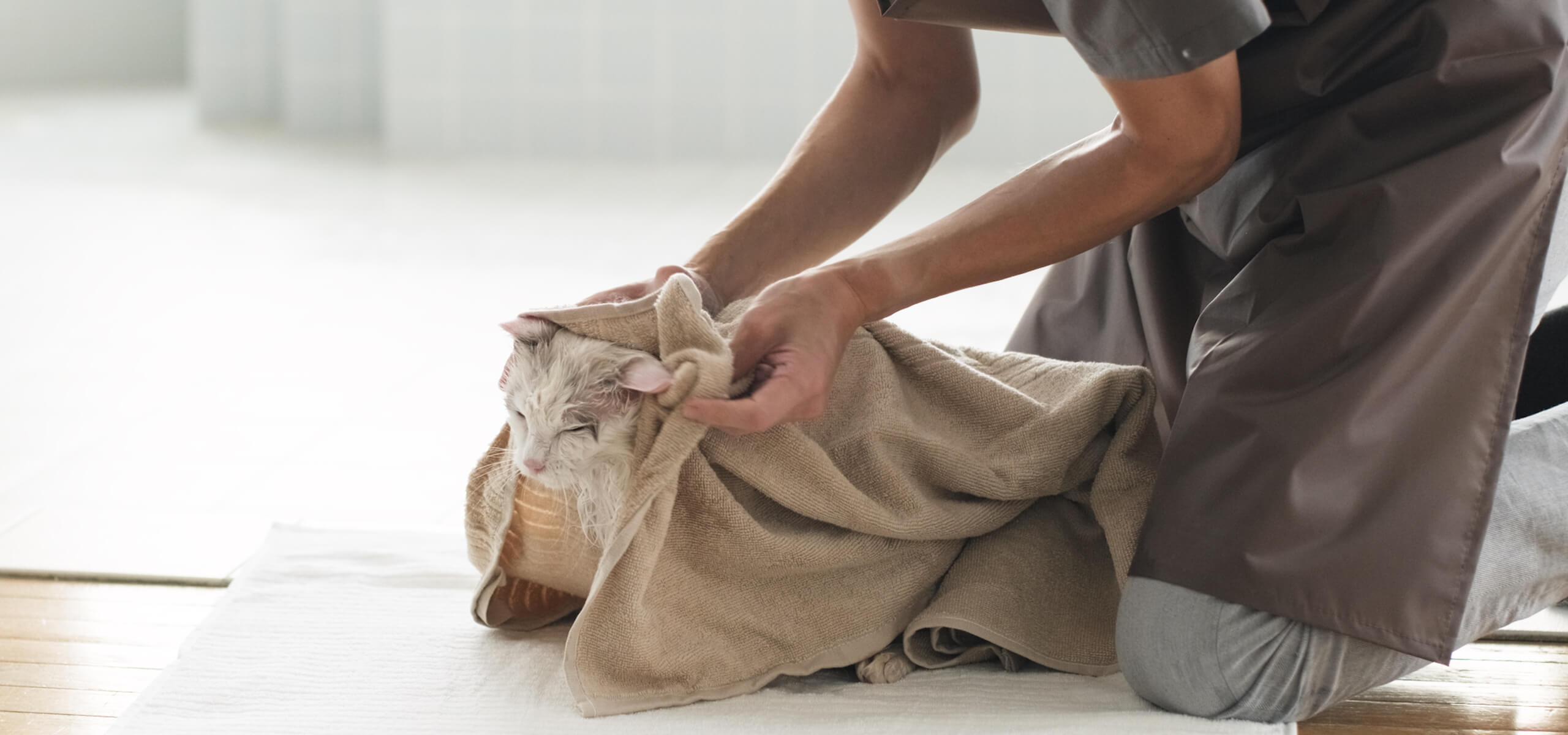
猫の被毛はいったん濡れると乾きにくく、そのままにしておくと体温を奪われてしまいます。そのため、シャンプーをした後は、手早く乾かさなければなりません。
猫の被毛を乾かすときには、バスタオル数枚、ドライヤー、コームなどを用意しましょう。
猫は顔が濡れたままの状態を嫌がるため、まずは顔を拭いてあげてください。その後、足やしっぽの付け根を軽く握り、手をスライドさせて水を切ります。ある程度水を切ったら、バスタオルで包み込むようにして拭いていきます。ゴシゴシこすることなく、上から押さえるようにして全身の水分を拭き取るようにしてください。途中、バスタオルを替えながら、おなかや忘れてしまいがちな足の内側もしっかり拭いていきます。
ドライヤーは一番弱い風量にし、音で猫を刺激しないよう、少し離した位置からあてていきます。このとき、被毛をかき分けて根元にあたるように乾かしていくのがポイントです。首や肩甲骨など、背中の高い位置から乾かしていくのもおすすめ。
ただし、猫によって嫌がる位置があるため、様子を見ながら行うようにしてください。
7猫のシャンプーを行う頻度
猫のシャンプーはあまり頻繁にしすぎてしまうと、皮膚のpHバランスが崩れたり、皮膚に備わっているバリア機能が低下したりすることで、皮膚トラブルの原因になってしまう場合があります。
短毛種であれば、特に汚れが目立つときに限り、年に1~2回の頻度にとどめておくようにしましょう。長毛種であっても、月に1回程度を目安としてください。また、皮膚トラブルのある場合、治療中の疾患がある場合はかかりつけの獣医師に相談しましょう。
8猫がシャンプーを嫌がる場合の対処法
猫がどうしてもシャンプーを嫌がる場合、どのような対処法があるのでしょうか。具体的には、下記のような方法があります。
シャンプーの合間などにご褒美を与える
シャンプーの合間やシャンプー後に、ご褒美としてお気に入りのフードやおやつを与えるという方法があります。
「シャンプーをすると良いことがある」と猫に印象づけることにより、シャンプー嫌いを少しずつ解消できる効果があります。
嫌がる猫に無理にシャンプーしない
シャンプーが本当に嫌いな猫の場合は、無理にシャンプーをしなくてもいいかもしれません。ペット用のバスタブや猫が安心できるサイズの洗面器などにお湯を張り、沐浴するだけでもいいでしょう。シャンプーをせずお湯で洗うだけでも汚れはある程度取れて、きれいになります。
また、すすぎのいらないドライシャンプーを使用したり、シートタイプの体拭きで体を拭いてあげたりするのも、被毛を清潔に保つためのケアとしては十分です。
電子レンジで温めるなどした蒸しタオルで体を拭いてあげるのも、ホカホカと全身が温まり、猫も気持ち良く過ごすことができるのでおすすめです。
9子猫のシャンプーはいつからできる?
生後、まだ日にちの浅い子猫は体温調節が満足にできず、免疫力は低い状態です。そんなときにシャンプーをすると、体温低下などで危険な状態になることも考えられます。ですから、子猫をシャンプーするのは、最低でも生後3ヵ月以上経ち、ワクチンを済ませてからにしてください。トリミングサロンでシャンプーをお願いする場合でも、ワクチン接種は必須です。ほかの猫と接触することにより、感染症にかかるリスクがあるからです。
また、初めてのシャンプーの前には、少しずつ水に慣らしていくといいでしょう。いきなりシャンプーをしてシャンプー嫌いになってしまっては、その後のお手入れに支障をきたしてしまいます。
10猫用シャンプーを選ぶ際のポイント
猫用のシャンプーは、どのような物を選べばいいのでしょうか。猫に最適なシャンプーや、反対に使ってはいけないシャンプーについてもご紹介します。
低刺激で香りの強すぎないシャンプーがおすすめ
猫の皮膚はとても繊細です。ちょっとした刺激でもダメージを受け、炎症を起こしやすいため、できるだけ低刺激のシャンプーを選ぶようにしてください。アミノ酸系で植物由来成分の、合成界面活性剤不使用のシャンプーが基本的にはおすすめです。
また、猫は非常に嗅覚が鋭い動物です。香りを嫌い、香りがストレスとなる猫もいるため、できれば無香料のシャンプーを選んでください。香りがついていたとしても、微香性のシャンプーがいいです。
なお、ノミ取りシャンプーは猫の皮膚への刺激が強いため常用はせず、どうしても必要なときだけ使用するようにしましょう。
人用のシャンプーはNG!
猫の皮膚は、人の皮膚とはpH値がまったく異なります。
人用のシャンプーを猫に使用すると皮膚が荒れるなどトラブルの要因となるため、猫には必ず猫用のシャンプーを使うようにしてください。
11ペティオおすすめの猫用シャンプーを紹介
猫用シャンプーといってもさまざまな種類がありますが、どのような商品がいいのでしょうか。今回は、ペティオが販売している猫用シャンプーの中から、おすすめの物を2点ご紹介します。
おすすめ商品
12正しい手順とポイントを押さえて、猫のシャンプー嫌いを克服しよう
猫にとってシャンプーは必須ではないですが、清潔感を保つためには定期的にシャンプーを行うのがおすすめです。
今回ご紹介した手順でシャンプーを行うことで、猫のシャンプー嫌いが少しでも克服され、シャンプーを少しでも楽しんでくれるようになるといいですね。
13
よくある質問
猫のシャンプーQ&A
- 猫にシャンプーは必要?
-
基本的には健康な猫にシャンプーは必要ありません。完全室内飼いの猫で、特に短毛種であれば、こまめにブラッシングをしてあげていれば、お手入れとしては十分です。ただし、皮膚疾患のある猫や、皮膚が脂っぽい、フケが出ている、排泄物で毛が汚れてしまったという場合は、シャンプーをしてさっぱり清潔にさせてあげることも必要です。
- 猫のシャンプーを行う頻度は?
-
短毛種であれば、特に汚れが目立つときに限り、年に1~2回の頻度にとどめておくようにしましょう。長毛種であっても、月に1回程度を目安としてください。猫のシャンプーはあまり頻繁にしすぎてしまうと、皮膚トラブルの原因になってしまう場合があります。
- 猫のシャンプーを行う上での注意点は?
-
長時間をかけてシャンプーをしてしまうと猫は大抵嫌がるため、全身を洗うのが難しければお尻周りと足先だけをまずは洗ってあげるようにしましょう。また、猫の表皮の厚みは約0.1mm程度しかなく、人間の赤ちゃんよりも薄いといわれていますので、シャンプーをするときは、ゴシゴシ強く洗いすぎて皮膚を傷つけてしまわないよう、十分注意しましょう。

